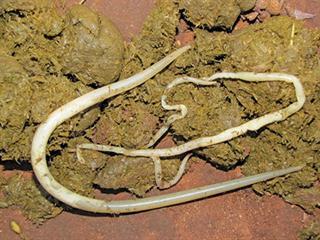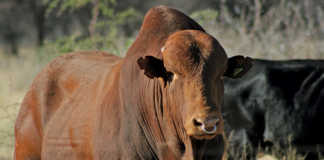
Several diseases/parasites can cross the animal-human barrier. Here are some of the more common:
Tapeworms
These can reach several metres in length. Segments of their bodies break off and are excreted in the faeces. Each segment may contain thousands of eggs. If ingested by animals or humans, the eggs find their way to the stomach, where they hatch.
The young tapeworms then migrate through the body. Some enter the muscles and other organs, where they form cysts (cysticercosis); others may remain in the intestines, leading to an infection called taeniasis. Two species of tapeworm are of significance to the farmer: the pig tapeworm (Taenia solium), which forms cysts in humans and pigs; and bovine tapeworm (Taenia saginata), which remains as a tapeworm in humans, but forms cysts in cattle.
- Symptoms: Animals seldom show any clinical symptoms that they have tapeworm. In some individuals, however, the worms remain in the intestine, and the animal appears ‘thin’. In pigs, they can sometimes be detected on the tongue, where they appear as small white cysts. In humans, the presence of tapeworms depends on the species. Cysticercosis gives rise to stomach ache, diarrhoea and poor appetite. Taeniasis is more difficult to detect but can grow large enough to become life-threatening.
- Prevention: On a well-run farm, the chances of picking up tapeworms are fairly small. The problem arises where hygiene is lax. The most likely cause of animals picking up tapeworms is through human excrement in paddocks where the animals are kept. Cattle pick up the eggs as they eat the grass on which the eggs are attached, and pigs become infected through eating human faeces.
Leptospirosis
This acute bacterial infection affects a wide variety of species. Leptospira can survive out of its host for several weeks, provided conditions are sufficiently moist. Even after recovering from an infection, an animal continues to excrete Leptospira through its urine. People can make contact with the bacteria, or the ground on which they were deposited, and become infected.
- Symptoms: Following an incubation period of seven to 12 days, leptospirosis manifests itself as a flu-like illness, with fever, severe headaches, intense pains in the calf and back muscles, and reddening of the eyes. Abdominal pains, diarrhoea and vomiting are not uncommon. Many people recover without undergoing any treatment. The acute strain of the illness (Weil’s disease), which is accompanied by jaundice and kidney failure, is thankfully rare. Treatment is with antibiotics.
- Prevention: Avoid contact with animal urine, control rats and mice – particularly in storage areas, and hang work clothing out to dry. The bacteria cannot survive in dry conditions.
Bovine tuberculosis
Mycotuberculosis bovis is a lung disease in cattle that can be transmitted through the air.
- Signs: Cattle with tuberculosis have tubercles (small lumps) in their lungs, intestines and other parts of the body. In humans, bovine tuberculosis causes abscesses in the lungs, but it can also invade other organs. The patient has a continual cough, pain in the chest and fatigue. The disease can result in death. Treatment is based on antibiotics. The disease is caught through drinking untreated milk or dairy products made from raw milk. It can sometimes be transmitted through the air, such as when humans and cattle live in close proximity.
- Prevention: Vaccinate new-born children with tuberculin vaccine. Test cattle with the tuberculin test; if it shows positive, the animal should be destroyed. Vaccinate livestock.
Brucellosis
This disease has been discussed in previous issues. It is transmitted through direct contact with a sick animal, or by touching aborted foetuses, placentas, secretions, birth channels or excrement.
- Prevention: Wear protective clothing (especially gloves) and have regular medical check-ups. Bury aborted foetuses and placentas and burn the grass or straw where an abortion has taken place. Vaccinate young female animals. Get your vet’s advice if your pigs show symptoms of the disease, as no vaccine is available for them.
Don’t risk it!
If you work with animals, and start to feel sick in any way, seek medical attention immediately. It’s far better to be safe than sorry.
Paul Donovan is Botswana-based biologist.













